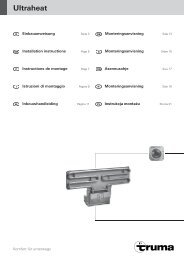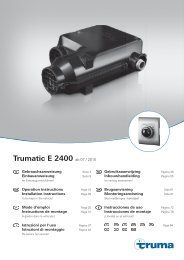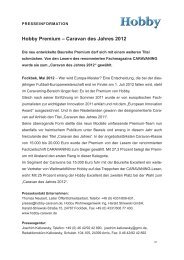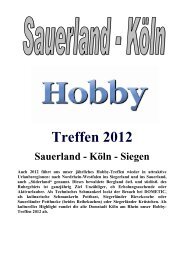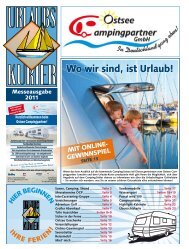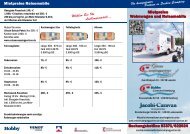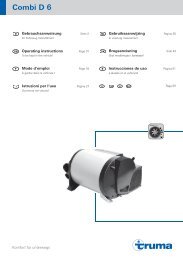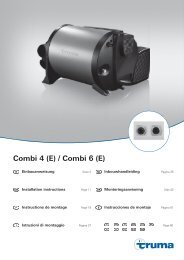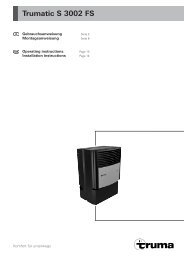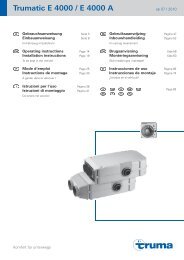Trumatic S 2200 / S 2200 P - Ostsee Campingpartner
Trumatic S 2200 / S 2200 P - Ostsee Campingpartner
Trumatic S 2200 / S 2200 P - Ostsee Campingpartner
You also want an ePaper? Increase the reach of your titles
YUMPU automatically turns print PDFs into web optimized ePapers that Google loves.
Fig. J2<br />
Use the heat deflector (25) when the radiation of heat is to be<br />
directed to the front or when connecting a fan for warm air<br />
distribution.<br />
Warm air distribution<br />
Fig. K<br />
All Truma fans are suitable for warm air distribution (Trumavent<br />
or Mulitvent). The fan can be attached to the floor or to the wall<br />
of the vehicle, near the heater.<br />
Fig. J2<br />
The connection to the heater is carried out using the intake<br />
nozzle DT (part no. 40660-00) with the Trumavent (for duct<br />
diameter 85 mm) or the intake nozzle DM (part no. 40670-00)<br />
with the Multivent (for duct diameter 65 mm).<br />
For this connection you require the installation box EKM or the<br />
rear panel RWS or RWSL with heat deflector. The Trumavent<br />
fans can also be directly attached to the installation box.<br />
You can use the component parts of the Trumavent system for<br />
further expansion of the warm air system.<br />
Gas connection<br />
The gas supply’s operating pressure (30 mbar) must<br />
be the same as the unit’s operating pressure (see type<br />
plate).<br />
The 8 mm diameter gas supply pipe must be attached to the<br />
connecting piece with a cutting ring connection. Carefully<br />
counterhold with another spanner when tightening!<br />
The gas connection fitting on the appliance is not to be<br />
made shorter or bent.<br />
Make sure the gas lines are free of dirt, chips and such prior<br />
to connecting!<br />
Choose a routing for the ducts which enables the appliance to<br />
be removed again for service work.<br />
Keep the number of parting connections in the gas supply<br />
line to an technically feasible minimum in areas frequented by<br />
people.<br />
The gas system must accord with the technical and administrative<br />
provisions of the individual country of use (in Europe,<br />
for example, EN 1949 for motor vehicles).<br />
National regulations and rulings (in Germany, for example,<br />
the DVGW worksheet G 607 for motor vehicles) must be<br />
respected.<br />
Function check<br />
After installation, the sealing tightness of the gas feed<br />
line must be tested in accordance with the pressure<br />
drop method. A test certificate (in Germany, for example, in<br />
accordance with the DVGW operational data sheet G 607) is<br />
to be issued.<br />
Following this inspection, test all functions of the appliance as<br />
specified in the operating instructions.<br />
The operating instructions and completed guarantee card are<br />
to be given to the owner of the vehicle.<br />
Warning information<br />
The installer or vehicle owner must apply the yellow sticker<br />
with the warning information, which is enclosed with the appliance,<br />
to a place in the vehicle where it is clearly visible to all<br />
users (e.g. on the wardrobe door)! Ask Truma to send you a<br />
sticker, if necessary.<br />
14<br />
Manufacturer’s terms of warranty<br />
1. Case of warranty<br />
The manufacturer grants a warranty for malfunctions in the<br />
appliance which are based on material or production faults.<br />
In addition to this, the statutory warranty claims against the<br />
seller remain valid.<br />
A claim under warranty shall not pertain:<br />
– for parts subject to wear and in cases of natural wear and<br />
tear,<br />
– as a result of using components in the units that are not<br />
original Truma parts and using unsuitable gas pressure<br />
regulators,<br />
– as a consequence of failure to respect Truma instructions<br />
for installation and use,<br />
– as a consequence of improper handling,<br />
– as a consequence of improper transport packing.<br />
2. Scope of warranty<br />
The warranty is valid for malfunctions as stated under<br />
item 1, which occur within 24 months after conclusion of<br />
the purchase agreement between the seller and the final<br />
consumer. The manufacturers will make good such defects<br />
by subsequent fulfilment, i.e. at their discretion either by<br />
repair or replacement. In the event of manufacturers providing<br />
service under warranty, the term of the warranty shall not<br />
re commence anew with regard to the repaired or replaced<br />
parts; rather, the old warranty period shall continue to run.<br />
More extensive claims, in particular claims for compensatory<br />
damages by purchasers or third parties, shall be excluded.<br />
This does not affect the rules of the product liability law.<br />
The manufacturer shall bear the cost of employing the Truma<br />
customer service for the removal of a malfunction under warranty<br />
– in particular transportation costs, travelling expenses,<br />
job and material costs, as long as the service is carried out in<br />
Germany. The warranty does not cover customer service work<br />
in other countries.<br />
Additional costs based on complicated removal and installation<br />
conditions of the appliance (e.g. removal of furniture or<br />
parts of the vehicle body) do not come under warranty.<br />
3. Raising the case of warranty<br />
The manufacturer's address is:<br />
Truma Gerätetechnik GmbH & Co. KG,<br />
Wernher-von-Braun Strasse 12,<br />
85640 Putzbrunn.<br />
In Germany, always notify the Truma Service Centre if problems<br />
are encountered; in other countries the relevant service<br />
partners should be contacted (see Truma Service Booklet or<br />
www.truma.com). Any complaints are to be described in detail.<br />
In addition, the properly completed guarantee certificate<br />
is to be presented, or the factory number of the unit and the<br />
date of purchase given.<br />
In order for the manufacturers to be able to determine whether<br />
an incident subject to guarantee has occurred, the end user<br />
must, at his own risk, bring the device to the manufacturers or<br />
send it to them. If there is damage to heaters (heat exchangers),<br />
the gas pressure regulator must also be sent back to the<br />
factory.<br />
In instances of the device being sent to the works, dispatch is<br />
to be effected by freight transport. In cases under guarantee,<br />
the works shall bear the transport costs or the costs of delivery<br />
and return. If the damage is deemed not to be a warranty<br />
case, the manufacturer shall notify the customer and shall<br />
specify repair costs which shall not be borne by the manufacturer;<br />
in this case, the customer shall also bear the shipping<br />
costs.



